By Scott Smith | Contributing Editor
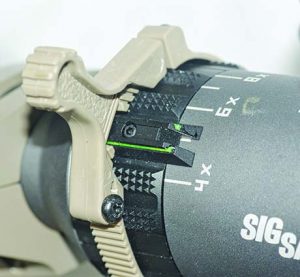
Close-up of the fiber optic tubes that allow you to see what magnification you are set at without removing your eye from the optic.
It was not all that long ago shooting competitions it seemed were limited to PPC, Camp Perry type matches, trap/skeet, black powder, silhouette and USPSA. Now we have Precision Rifle Series, 3-Gun in many forms, Cowboy Action Shooting, USPSA, IDPA, NRA Law Enforcement, various outlaw action shooting events; pretty much whatever you shoot, there is a competition for it.
What all of the new action shooting events have done is force manufacturers to make optics to fit the events and price point criteria. This issue we are going to look at variable power optics for precision/long range rifle, 3-Gun optics and mini red dots that are ideal for Carry Optics and Pistol Caliber Carbine competition. One thing we will be keeping in mind is the price; we don’t want to break the bank.
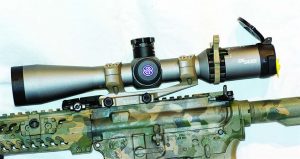
Sig’s Tango 6 mounted atop a Stag 3G AR using a Warne XSkel Mount and MGM Eagle View throw lever to make zooming the Tango faster and easier.
Precision Rifle Series (PRS) is unique in the Production Division. This division is targeted at folks who are new shooters and those who do not or cannot afford a rifle/optics package that rivals new quad. Production caps the price of the rifle and scope at $2000 each and there is a list of “approved” rifles. I know some folks will shake their head thinking they do not spend that much for a rifle and scope. Trust me I understand, but in reality when gearing up for most any competition, it’s expensive.
For the PRS optic I went to one of my go-to companies: Sig Sauer (Phone: 603-610-3000; Online: sigsauer.com)— yes the folks who make possibly the best duty pistol in the world, the P226. A few years back Sig introduced the Electro-Optics Division. I use one of their Romeo 4T red dots. Over the last couple of years it has traveled cross country a couple of times and has never lost zero. I talked with a few of my industry buds and they all had good things to say about the variable power rifle scopes.
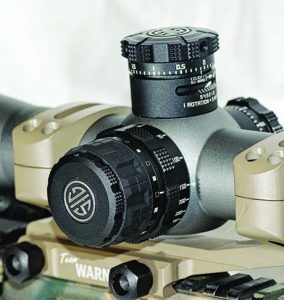
View of the adjustment turrets and the illumination/parallax adjustments, all big and easy to see under pressure.
The Tango 4: SOT44002 is a 4-16X44 30mm scope with three reticle options: MRAD-DevL, MOA DevL, and MRAD/MOA. You will have first focal plane reticule, the reticle stays the same size as you change magnification. Like the debate over Mil Radian versus Minute of Angle Optics, first versus second focal plane is one of the great optics debates. I prefer first focal plane optics and have no preference about MRAD versus MOA optics; both work well.
Now back to the Tango. It is stealth grey, with all black accents; it’s a really good looking scope. The Sig Turrets are laser etched with all the numbers/hash marks in white. There are 78 MOA (.25 MOA adjustment) and 22 MRAD (.1 MRAD adjustment) range for windage and elevation. The magnification ring has two green fiber optic tubes so you can see roughly the magnification without coming off the gun. You will notice a third turret on the left side of the scope; this controls the light intensity of the reticle and the parallax. Trust me Sig packs a lot of features and technology into the Tango Series.
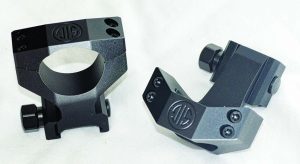
Sig’s Alpha Mount/Rings will survive the harshest use.
When you purchase the Tango, you can order the Sig Ballistic Turret for elevation. This turret is tuned precisely for the load you shoot based on caliber, bullet weight, ballistic coefficient, elevation and velocity of your bullet. Once installed and zeroed, to shoot at 400 yards, rotate to 4. Watching the video about the SBT online, it looks like Sig is onto something with this.
While Sig makes an awesome set of rings that retail for $109.99 and do hold repeatable zero, I wanted a one piece unit. I turned to Brownells and ordered a Warne X-Skel Extended Mount. At $137.25 this mount ensures that I have repeatable zero, because I use my Stag 3G as my test bed for optics. The combination of the Warne mount and Sig Tango 4 scope on the 3G created a wicked accurate rifle.
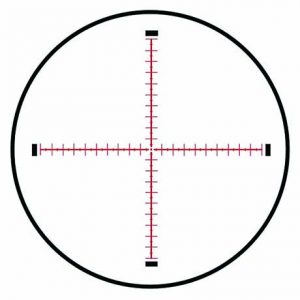
MRAD MOA Reticle the author used. It’s fast and accurate once zeroed.
If I did my part and held the rifle steady, walking bullets around the center of the target was possible. The key when doing this is to remember how many clicks you move the crosshairs in each direction to make it easier to return to zero. Once you have the scope zeroed to your rifle/load, loosen the three set screws in the adjusting knob and set the adjustment knob to “0” for your firearm, scope and ammunition combination.
The Sig Sauer Tango 4 will serve you well on the competition field, hunting, in a tactical environment and just plinking for years. If something does go wrong with your scope the “Infinite Lifetime Warranty” will correct the problem. The Sig Sauer Tango 4 is a scope that rivals competitors that cost twice as much, like Sig’s handguns; the Tango 4 has to-hell-and-back durability. You will not go wrong with it.
If you have read any of the numerous firearms magazines in print or online, you are aware of the current driving force in shooting: 3-Gun competition. Three gun competitions like action pistol shooting in the nineties is even driving the military and law enforcement communities. Nowhere else save for a combat zone does equipment get stressed like it does in competition—from the varied shooting positions, conditions, styles of shooting, vast numbers of rounds fired to the pounding gear takes being tossed into a dump barrel. Shooters demand gear that will endure this torture and perform on demand.
While it is easy to find expensive gear to meet these requirements, not all of us can afford to spend thousands for optics. Over the last few years I have looked for optics for the average shooter who has to pay for their kid’s braces and mortgage. I found the Lucid Optics L7 (Phone: 307-840 -2160; Online: mylucidgear.com) scope and QDM mount to be one of the best options on the market. With an MSRP of $449 for the scope and $159 for the mount, the price is hard to beat. What makes this combination such a good value is that performance exceeds price.
At first glance the L7 looks like most 1-6X24, 30mm short to mid-range optics. You would be remiss thinking it is. When you look closer you notice the threaded magnification throw lever. This is a simple item, but one that is needed for fast changes on a 3-Gun stage.
When looking through the optic, you notice the reticle is a second focal plane so the “size” varies through magnification. What truly sets this scope apart from the competition is the blue reticle illumination. For those who are color blind the red or green reticules of other scopes are black or grey. This defeats the purpose of having an illuminated reticle, negating the speed and fast acquisition of the aiming point to target. The blue seems to overcome that issue. About the only conditions it seems to fade in is bright flat light where the light washes out the blue. This optical problem is one that occurs with the red or green diodes in morning/evening light or against lush green backgrounds. The blue diode is great though because you do not have the wash in heavily wooded areas or in the desert southwest.
You will find the elevation, windage adjustments have locking turrets. They are of the push-pull variety and you will not easily knock off. The pull to unlock the turret requires a purposeful effort. The adjustments are then smooth and each click is positive. There are 60 half MOAs of adjustment on either side of center, giving you plenty of adjustment for all but half mile shots with an AR. I found the scope easy to zero thanks to the positive adjustment clicks. It was actually within two inches of zero at 50 yards on my Saint when I mounted the L7 on the QDM.
Once zeroed at 50 yards I had no problem hitting Birchwood Casey’s World of Targets Steel Popper at ranges out to 200 yards. Essentially this is a half scale pepper popper (25lb) that is easily moved to and from your range versus a full sized popper that requires a crew. That might sound like no big deal, but the target is an eight-inch area that you shoot from whatever position the stage design allows the shooter to take. The Target Steel Popper’s details will be featured later in the year.
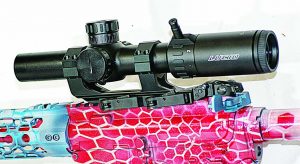
Lucid’s L7 Scope mounted atop a Springfield Armory Saint for 3-Gun competition. It’s a formidable combination.
Over the last five months, my sample of the L7 has traveled from Pittsburgh to Vegas and all over the tri-state area in my RV. It has been tossed in and out of the back of the truck heading to the range and zero has not shifted. When I travel I do not use a heavy hard case, I use a simple soft padded carbine case so the scope has been jostled and bumped. I am impressed with the L7. This scope will also be ideal for the fast action of USPSA’s Pistol Carbine Class or use on a patrol rifle for duty.
If the L7 lives up to the feedback I have gotten about the HD7 red dot, this scope will be seen on ranges across the country. Several folks whose opinions I trust tell me the HD 7 gives the shooter a helluva lot of bang for the buck. From what I have seen of the L7, it gets two thumbs up. It is a scope I have and would run for three gun. I like it—a lot.
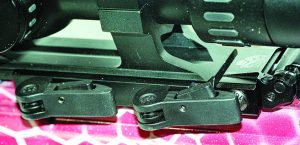
The locking levers of Lucid’s QDM Mount.
The last competition optic we are going to look at is a miniature red dot sight, aka MRDS. MRDS optics are rapidly being accepted because of the growth of handguns designed to accept them and the availability of offset mounts for ARs. While handgun manufactures are working to build factory optics-ready pistols, optics companies are building optics that can endure the recoil, extremes of weather and rigors of hard use.
One of the leaders of this revolution is Meopta (Phone: 800-828-8928; Online: meoptasportoptics.com) which has been manufacturing precision optics since 1933 in Czechoslovakia. In 1988 the company returned to manufacturing firearms optics, something they had not done since WWII. From 1992 to 2003 Meopta had a cooperative agreement with TCI, an optics lab in Long Island. In 2004 Meopta expanded into the US market through TCI. Finally in 2005, TCI and Meopta –optik s.r.o. merged to form Meopta USA. Today Meopta is a force in shooting optics that is often overlooked by shooters because they do not run multi-gazillion dollar ad campaigns. They just build quality glass for shooters.
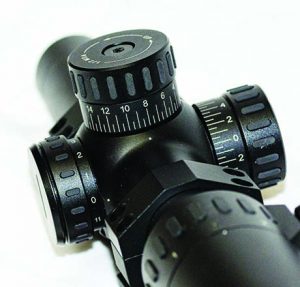
Competitors can quickly adjust the scope settings thanks to the large knobs on the L7.
Lately I have been shooting the Turkish-built Canik TP9SFx, a five-inch 9mm pistol that ships with MRDS sight mounts, one that fits the Meopta MeoSight III. So it seemed like a good idea to merge two of Europe’s largest shooting companies for this portion of the review.
Unlike many of the MRDSs, this sight has an on/off switch. Even with the incredible long run life of modern minis, I prefer to be able to shut it off for storage. I know I am old school. When shut off, the MeoSight III does not return to a default setting; it stays at whichever of the eight intensity settings you were using when turned back on. Weighing a scant thirty-five grams this sight is ideal to mount on a handgun. With its 3MOA (5MOA available), this sight provides the shooter with a bright precise aiming point.
One feature that sets this sight apart from others is the notch sight at the rear of the sight. I found when you centered the dot in this notch, accurate shots were possible at ranges out to 50 yards. Meopta ensures your sight stays set by using dual lock screws on the rear of the sight housing. The locking screws and adjustments are easily performed with the small flat tip screwdriver shipped with the sight. If you lose it, one of the eyeglass screwdrivers you can buy at the checkout of a dollar store will work.
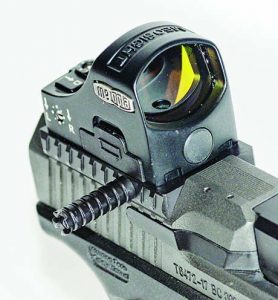
Meopta’s MeoSight III rests on author’s well traveled Canik TP9SFx; this combination is ideal for USPSA’s Carry Optics Division.
At the range I found the MeoSight III easily adjusted to zero. I don’t recall the load I zeroed the Canik/MeoSight III with, but all the ammo I fired was dead on at 25 yards. It seems gone are the days of wide variances in POA/POI unless we are talking about truly specialized loads like those for steel challenge type matches which tend to be much lower velocity than SAAMI specification ammunition.
After running several hundred rounds downrange with the MeoSight III on the Canik TP9SFx, I can see why folks are shooting Carry Optics in USPSA. Those of us with well over 50 eyes can see those glowing red dots. This MRDS would be ideal for PCC and as an offset sight for Open Class in 3-Gun competition. With its $399 price online, this sight is priced to compete with other mini red dot sights. Keep your eyes open for Meopta’s latest MRDS, the MeoRed; it is built to meet the demands of competition shooters. With either the MeoSight III or MeoRed you will not go wrong.
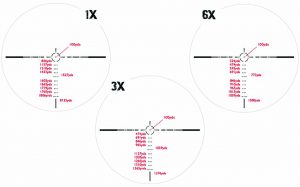
Three views of the reticle as it zooms in the L7.
As you can see the world of competition optics has something for everyone and every match type. In the 25 years I have been writing, optics manufacturers have been listening to the civilian market, specifically the competition market, more and more. This section of the market is driving the hunting and tactical market. The manufacturers are offering better quality optics, more features and scopes to meet all price ranges. The three optics I’ve discussed here show the barest minimum of optics on the market today, but they cover the three basic types. Thanks to the Internet you will be able to find optics to meet your needs and price range. Whatever you shoot, remember to shoot safe, shoot straight and have fun.



